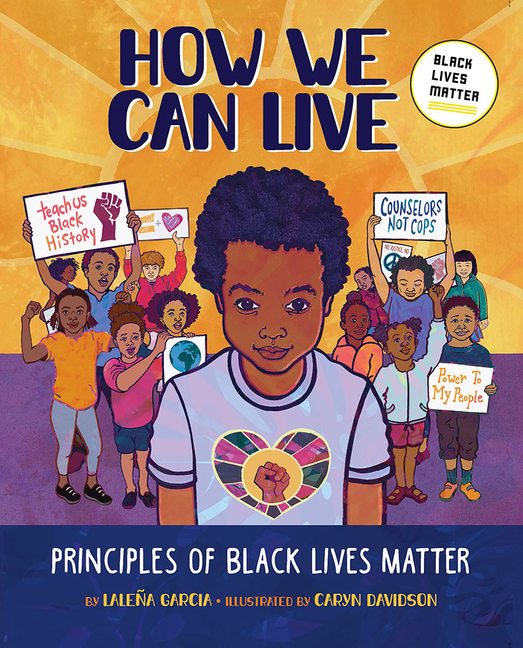
Book Resume
for How We Can Live: Principles of Black Lives Matter by Laleña Garcia and Caryn Davidson
Professional book information and credentials for How We Can Live.
- Kirkus:
- Ages 8 - 12
- Publisher's Weekly:
- Ages 4 - 10
- School Library Journal:
- Grades 1 - 5
- TeachingBooks:*
- Grades PK-6
- Cultural Experience:
- African American
- Genre:
- Nonfiction
- Picture Book
- Year Published:
- 2020
6 Subject Headings
The following 6 subject headings were determined by the U.S. Library of Congress and the Book Industry Study Group (BISAC) to reveal themes from the content of this book (How We Can Live).
3 Full Professional Reviews (1 Starred)
The following unabridged reviews are made available under license from their respective rights holders and publishers. Reviews may be used for educational purposes consistent with the fair use doctrine in your jurisdiction, and may not be reproduced or repurposed without permission from the rights holders.
Note: This section may include reviews for related titles (e.g., same author, series, or related edition).
From Kirkus
October 15, 2022
A young people's primer on the Black Lives Matter movement. After defining principle in the introduction, this book explains the movement's 13 principles, offering a brief explanation for each along with several questions to help readers consider the implications. While some famous activists appear in the illustrations, so do many "everyday people." Davidson includes visual motifs throughout of beautiful shapes with embedded silhouettes of Black and brown faces; hearts and Black Power fists appear, too. On each verso, Garcia discusses a principle and ends with biographical notes on people who are illustrated on the recto, most of whom gaze out at readers. The text's density and frequent inclusion of specific terms may limit children's ability to use the book independently, though the "Afterword for Adults" encourages caregivers to have potentially difficult conversations with young people. While children also appear on the cover and occasionally in the images, the book doesn't highlight children who have made or are making change. Still, this is an important book that will help adults and young people alike understand and appreciate the Black Lives Matter movement. A timely, informative, and inspiring read. (Nonfiction. 8-12)
COPYRIGHT(2022) Kirkus Reviews, ALL RIGHTS RESERVED.
From Publisher's Weekly
October 10, 2022
Published with the Black Lives Matter Global Network Foundation and structured around guiding principles used by Black Lives Matter at School, this authoritative, information-dense book defines Black Lives Matter principles for young readers. In an introduction, Garcia writes that the phrase serves as both reminder and promise: “We are REMINDING ourselves and others that the world is still not fair, and we are PROMISING to work to make the world fair.” Subsequent spreads define concepts in kid-friendly language, among them unapologetically Black, empathy, loving engagement, and restorative justice, alongside terms of inclusion, such as intergenerational, and queer- and transgender-affirming. Davidson’s crisp portraiture—which depicts historical leaders, contemporary activists, and everyday people—is presented alongside facial silhouettes that form repeating motifs of hearts, florals, starbursts, and abstract patterns. An adult-oriented afterword balances information for readers in this basic introduction to an organization and a movement. Ages 4–10.
From School Library Journal
Starred review from September 30, 2022
Gr 1-5-This picture book was created by the three founders of the Black Lives Matter Global Network Foundation, Alicia Garza, Patrisse Cullors, and Opal Ayo, who developed a set of guiding principles that honor the value of Black women, families, and LGBTQIA persons. Since its inception in 2013, the Black Lives Matter Movement has been instrumental in highlighting racism, discrimination, and racial inequality towards Black people. This book reaffirms those principles into language that children can connect with. For example, the BLM Principle of Diversity advocates, "We are committed to acknowledging, respecting and celebrating difference(s) and commonalities." Here, it is written for children as, "When we get to hear ideas from lots of people, we get smarter, when we work together, our communities get stronger." Each BLM guiding principle is reworked to stay true to the source but accessible to children, with thoughtful guiding questions for further reflection and discussion. In addition, each principle includes brightly colored illustrations of modern or historical Black activists, artists, or everyday community members. An introduction explains the origins of the BLM movement and an afterword for adults includes advice for how to deal with questions young people might have about racial inequality or injustice. Exceptionally well-written, it offers many opportunities to further the discussion of BLM without focusing on violence but instead instilling hope. VERDICT An important message for all young people, this is approachable but profound in its message, and a welcome addition to any elementary library.-Carol Connor
Copyright 2022 School Library Journal, LLC Used with permission.
Preview Digital Book
Explore How We Can Live on Marketplace. Access requires OverDrive Marketplace login.
This Book Resume for How We Can Live is compiled from TeachingBooks, a library of professional resources about children's and young adult books. This page may be shared for educational purposes and must include copyright information. Reviews are made available under license from their respective rights holders and publishers.
*Grade levels are determined by certified librarians utilizing editorial reviews and additional materials. Relevant age ranges vary depending on the learner, the setting, and the intended purpose of a book.
Retrieved from TeachingBooks on October 14, 2025. © 2001-2025 TeachingBooks.net, LLC. All rights reserved by rights holders.





